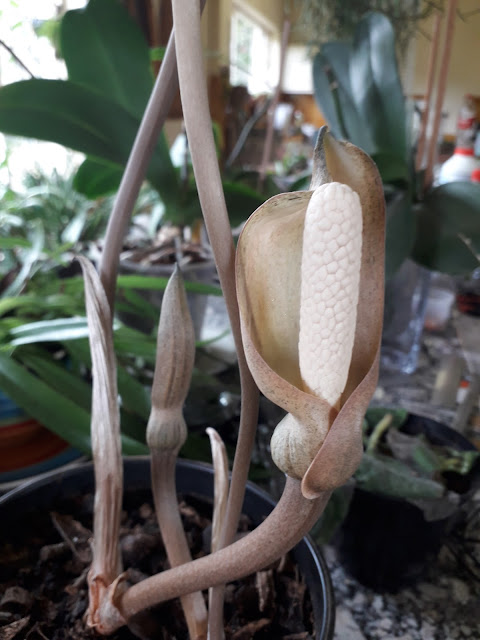Synaptolepis oliveriana, Uvuma omhlope
I found a very interesting much
sought after medicinal plant Synaptolepis oliveriana locally known as uvuma
omhlope belonging to the plant family Thymelaeaceae growing
in the eMalangeni Forest. Synaptolepis oliveriana known both locally and abroad
as uvuma omhlope has a natural distribution from northern KwaZulu Natal into Southern
Mozambique where it grows in the following vegetation types, Palm Veld and
Wooded Grassland, Sand Forest, Northern Coastal Forest, Lowveld Riverine
Forest, Maputaland Wooded Grassland, Maputaland Coastal Belt, Subtropical Dune
Thicket.
Description
Synaptolepis oliveriana, Uvuma omhlope is a small multi-branched scrambling shrub with dark brown, nearly black stems and blue-green spear shaped leaves. The large, fibrous roots are a striking porcelain white.
The flowers are tubular and
white with orange pollen typical for plants in the plant family Thymelaeaceae. The fruits are a small yellow to orange berry
which are very good to eat.
The fruits of Synaptolepis oliveriana are a small yellow to orange berry
Traditional uses
The roots of Synaptolepis
oliveriana, Uvuma-omhlope traditionally are used by
the local Zulu people to produce clear visions when entering trance and to help
diviners gain clarity. The root is said
to help one to communicate with one’s ancestors, to lead to visionary and
prophetic dreams, and to aid in divination and in gaining answers to specific
questions.
A local traditional house used by a traditional healer that I photographed near to the eMalangeni Forest
It has been established that the
roots contain several novel alkaloids including a potent neurotrophic protein called
kirkinine that induces the development and function of neurons in the brain. It
is therefore considered as a brain tonic!
The roots of Uvuma-omhlope are quite large and are usually cut in to pure white chunks containing brown fibres in the centre.
The dry roots are pounded into a white powder. Uvuma-omhlope taken before sleep is often
combined with other plants to create root infusions for the purpose of
divination. It is reported that 300 mg of the dried root powder is sufficient
to elicit lucid dreaming. Users also report feeling an increase in well being
and happiness, that it alleviates anxiety, has disposition lifting properties,
and that it averts impatience.
Threats
According to the South African
National Biological Institute,
Red List of South African Plants at http://redlist.sanbi.org/species.php?species=2938-2
this species is threatened due to over exploitation.
Guided excursions
Guided excursions in English, Zulu and German into the eMalangeni Forest and surrounding area including the nearby Tembe Elephant Park can be arranged. Please visit my websites for contact details.
Michael Hickman
04.04.21
Please visit my websites at
as well as my other blogs at
http://luthulienvironment.blogspot.com/
http://ecomandurban.blogspot.com/















